| |
|
|
| |
A river of two halves.
Thu 29th September, 2011
|
|
|
|
Update 4th October 7.45am
After met service issued a severe weather warning for National Park we had periods of very heavy rain and thunderstorms last night. One lightening strike knocked all power out and was probably the biggest I've seen. The Tongariro peaked at 264 cumecs and is currently at 164 cumecs...stay in bed guys.
Update 4th October 6.15pm
The Tongariro has dropped quickly throughout the day and is now running at around 30 cumecs. Still carrying a lot of color but by tomorrow things should be perfect.
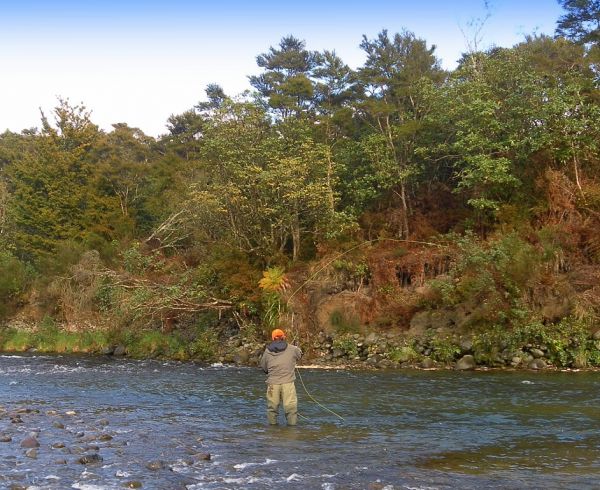
Everything is right with the world this week. There are fish in the river to catch, the AB's and Wales march on and with the settled weather and much lighter evenings its been a great time to be on the Tongariro. Towards the end of last week there was a more even spread of fish and anglers did well with some good fresh hens in the middle and upper reaches. The last few days we seem to have returned once more to a river of two halves. The better fish are coming from the Hydro down unless I've just been unlucky. I had two top blokes out on Sunday, Mark Tomsett who I've guided before and his long-time mate Terry "Coozer" Cooney. 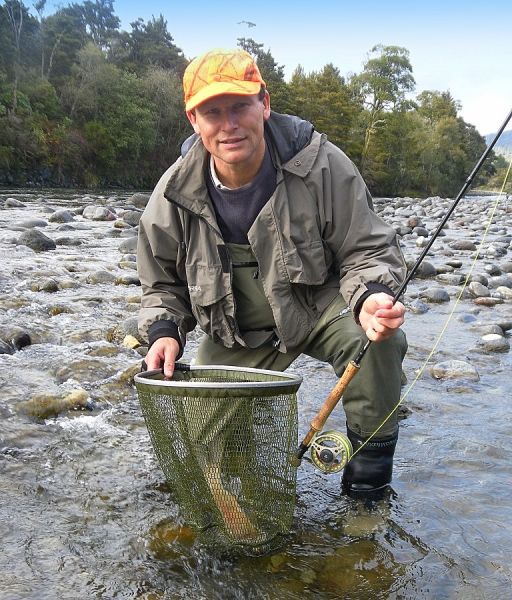 They both used to play rugby together but this trip was just going to be a bit of fun...not a competition you understand...yeah right! They both used to play rugby together but this trip was just going to be a bit of fun...not a competition you understand...yeah right!
It got off to a some what chaotic start because we had spent Saturday night watching the All Blacks stuff France. A celebratory bottle of red and a few beers meant I forgot about day-light saving. Over at Tongariro River Motel Mark remembered for all of us but he put his clock forward twice and got up at 4.00am. Terry didn't remember much at all and had gone back to his bed. When I arrived 15 minutes late he couldn't even remember how to tie his boot laces up. The original plan was to explore the middle river, with that in mind we were going to park one vehicle at the Red Hut bridge. Then drive the other back to our intended starting point at the Hydro and go up the TLB before crossing over below Kamahi. But it was still pitch black so we headed over to the Braids for a quick flick to kill some time. Much to our surprise there were already a couple of other anglers waiting for sun up and I suspect we weren't the only ones caught out. Mark knows this area of the river fairly well but it was Terry who was "one up" by the time it was light enough to head upriver. Forty minutes later he had increased this to two and even though this wasn't a competition his mate was putting in a lot of short fast drifts. After I netted number three, even Terry felt sorry for him and swopped rods, and the ungrateful bugger hooked into one almost straight away.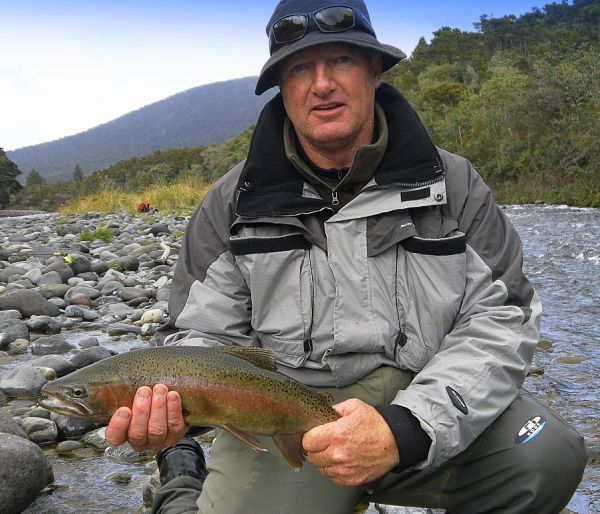 Ten minutes later he was in again landing this little jack which fought well above its weight. They weren't counting but this made things all square as we waded above Never Fail to the TRB. This is a longish upriver crossing in medium flow water and a bit tiring on the legs. Ten minutes later he was in again landing this little jack which fought well above its weight. They weren't counting but this made things all square as we waded above Never Fail to the TRB. This is a longish upriver crossing in medium flow water and a bit tiring on the legs.
If you attempt this one its probably safer to buddy up or at least use a wading stick.
Kamahi is one of the Tongariro's pretty pools and a good place for a lunch break and a couple of cold beers. It also holds a few fish and Mark nailed one of a group we spotted in the tail, making it four...three. We continued upriver fishing Stag, Mill Race, Silly and the runs in between. They lost another one each but it wasn't really happening with no sign of any better looking fish. Considering it was a Sunday afternoon there were very few anglers around, we saw just two others all day between the Hydro and Red Hut bridge. With an hour or so left we returned to an almost deserted Braids. On the second cast Terry's indicator vanished and the rod had a pretty healthy bend in it as the fish took full advantage of the fast water. But this one was not to be and it let go as we steered it carefully towards the shallows. Mark was fishing just upstream and hooked up a few minutes later. By the end of the day he had two from this stretch that were destined for the smoker. You get a great deal of satisfaction from guiding, especially if you get a few fish. Despite the "mickey taking" these were two old mates out for some down time on the river, I think they enjoyed it as much as
I did...great day out guys.
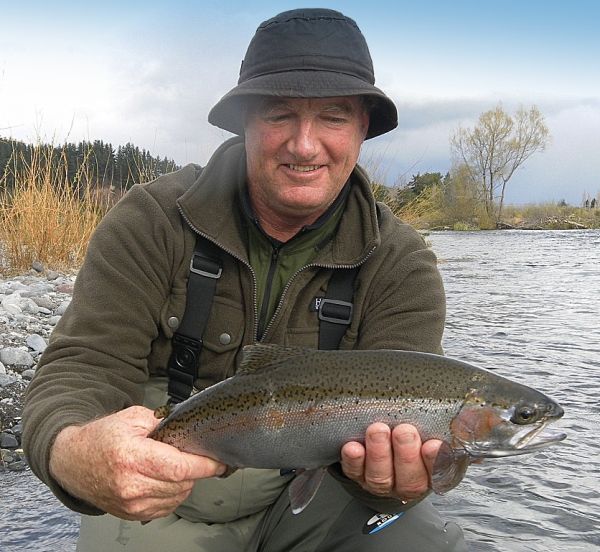
Now Part Two of the "Extraordinary Rainbow" from Ron Newman's informative article at www.bcadventure.com
" Ears? No, the Rainbow doesn't have an external ear yet it can hear sound better than almost all land animals. The trout's three-chambered 'internal' ear picks up sound very well. If you drop your glasses in the bottom of the boat, a trout across a large lake will easily hear that sound and the nearby trout will probably be spooked into a non-feeding phase by the noise. The ear also serves as an organ for balance. Land animals use fluid in the ear for balance. In a fluid environment, the trout uses calcified stone in each ear chamber to help it tell up from down and left from right.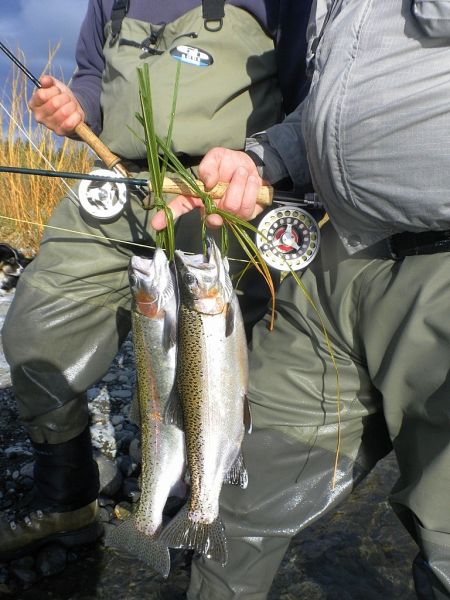
The senses of taste and smell are particularly well developed in the Rainbow Trout. They are better developed than the legendary Bloodhound and about 500 times more sensitive than these senses in a human. It is believed that Rainbow Trout, steelhead and salmon (all of the scientific Order of Oncorhynchus) use taste and smell to help locate the waters of their original spawning streams.
A Rainbow Trout can smell the difference between two aquatic plants of the same species that are side by side. It can even taste the difference between two species of Chironomid and thus will have a preference for one species over another. Rainbow Trout are very sensitive to differences in ph, salinity and the differences in amino acids as found in their food sources. It is thought that the Rainbow may even have taste and smell sensors on parts of its body other than in the nostrils and mouth and that these may actually help the trout in locating its food. 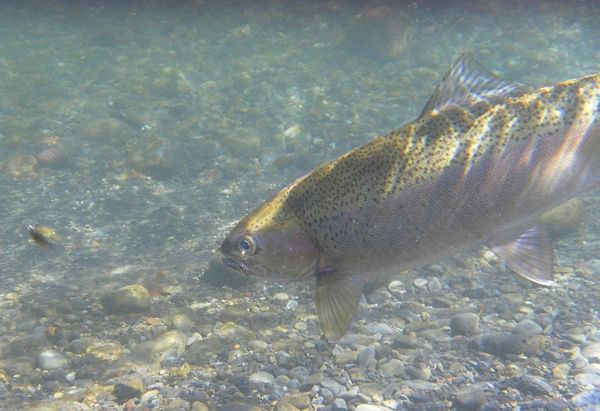
Would you believe that we have yet to come to the most astounding aspect of the trout's senses? Besides the normal touch sense that most animals have, the Rainbow Trout has what scientists are calling the "Distant Touch" sense. This is sort of like Extra-Sensory Perception or ESP.
The scientists aren't exactly sure how this all works but here are a few of the known details.
Water is 800 times denser than air. In part, this is why the trout can hear, smell, taste and see color so well. As a denser medium, water carries the mechanisms for sensory input much better than air. The senses of touch and perception are no different.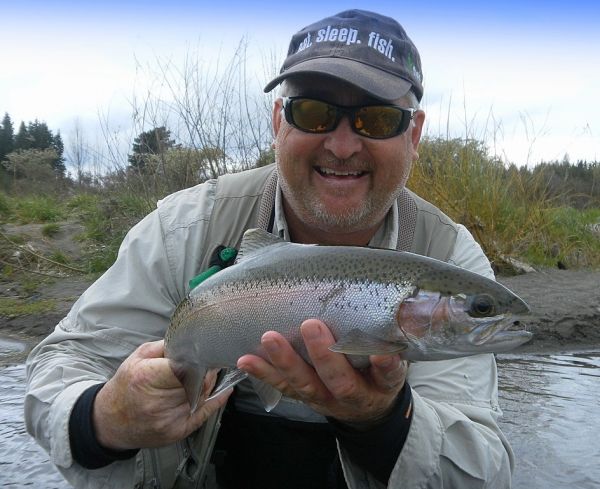 The Rainbow can feel and perceive distant objects or movements about 800 time's better than we can and may even have a form of echolocation. Imagine that someone drops a ball of cheese at the other end of a football field. The Rainbow can feel and perceive distant objects or movements about 800 time's better than we can and may even have a form of echolocation. Imagine that someone drops a ball of cheese at the other end of a football field.
Other than the fact that you saw it drop, you probably wouldn't know that it had happened.
At that distance, with its eyesight, a Rainbow
Trout wouldn't see the cheese ball drop.
However, underwater it could 'feel' the concussion of the cheese ball hitting the ground, hear the sound it makes when it hits and may even be able to smell and taste the cheese shortly after the hard outer cover breaks. It is even possible that, through echolocation, the trout could tell us exactly where the cheese ball hits in the end zone.
A person capable of doing the same would be considered to have ESP. The trout's primary receptor for this ability is the Lateral Line. It is also known that the Supra-Orbital and Sub-Orbital lines on the jaw and back on the trout's skull play a similar role. The trout may have other distant touch receptors of which we are yet unaware. The full sensory capabilities of the Rainbow Trout are yet to be determined by the scientific community. With its distant touch sense, a Rainbow can detect the slightest movement of an aquatic bug (or fly) at quite a distance and even on the darkest of nights.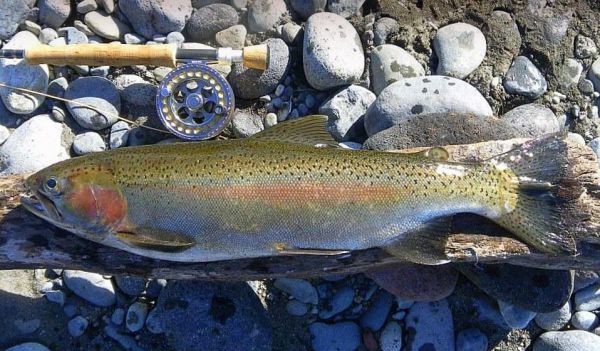 It can just as easily detect if the movement is wrong. For the fly fisher, the reward comes when the trout 'inhales' the fly very softly. That's a sure indication that the trout is feeding on the fly rather than taking it out of aggression or territorial protection. It can just as easily detect if the movement is wrong. For the fly fisher, the reward comes when the trout 'inhales' the fly very softly. That's a sure indication that the trout is feeding on the fly rather than taking it out of aggression or territorial protection.
They will 'strike' a fly, sometimes very hard, for a number of reasons but they will only 'inhale' the fly when they are confident that it is their desired food source. In human equivalents,
we seem to have an animal that is faster than a speeding bullet, able to leap tall buildings in a single bound, is stronger than a charging locomotive and even has its own form of X-Ray vision or an equivalent there-of. Remind you of anyone? I'm not sure about you but I consider the Rainbow Trout to be the Superman of the animal kingdom. If we were handing out awards, I would certainly vote for Mother Nature and her creation of the Rainbow Trout." Thanks to Ron Newman for these amazing facts.
While on the subject of feeding trout the numbers of Mayfly presently in the river are awesome. The hatches have been building steadily for weeks and if you turn over a few rocks you"ll see why. I thought I had taken a pic of one about the size of my hand which had dozens of nymphs on the under-side but I can't seem to find it. I've seen the odd rise and it won't be long before they tune in properly to this plentiful food supply. In the meantime small pheasant tails and other skinny tied patterns are a good choice to imitate the nymphal stage. Pat from Queensland did just that and was pretty pleased to land the nice fish pictured above right.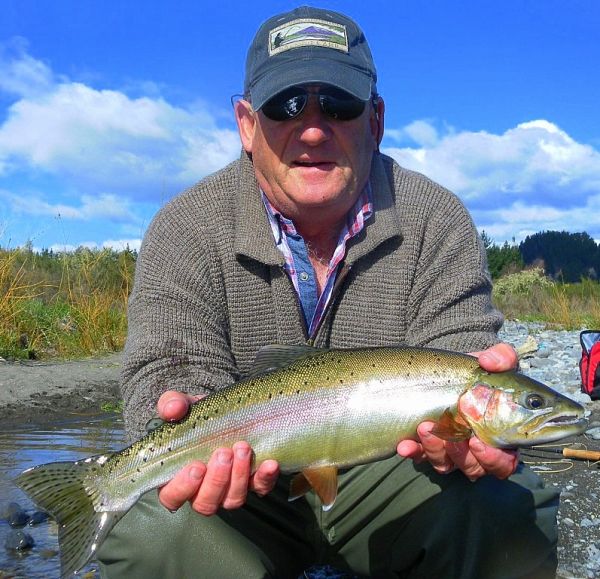 If they get a bit fed up with them a great alternative is the fly pictured below. Its called a "Wiggle Nymph" and has an articulated body. I haven't seen them in the tackle shops but they are simple to tie and fish really nail them. On my way downriver I've fished the Braids a few times and noticed that the true right bypass is also giving up some better fish again. It was "hot" earlier in the year especially around the Plank. With the clearer conditions its been a bit quiet but I've taken some nice big hens there this week. If we get the rain on Sunday and the river colors a little, it may be worth giving Spot X a go. If they get a bit fed up with them a great alternative is the fly pictured below. Its called a "Wiggle Nymph" and has an articulated body. I haven't seen them in the tackle shops but they are simple to tie and fish really nail them. On my way downriver I've fished the Braids a few times and noticed that the true right bypass is also giving up some better fish again. It was "hot" earlier in the year especially around the Plank. With the clearer conditions its been a bit quiet but I've taken some nice big hens there this week. If we get the rain on Sunday and the river colors a little, it may be worth giving Spot X a go. 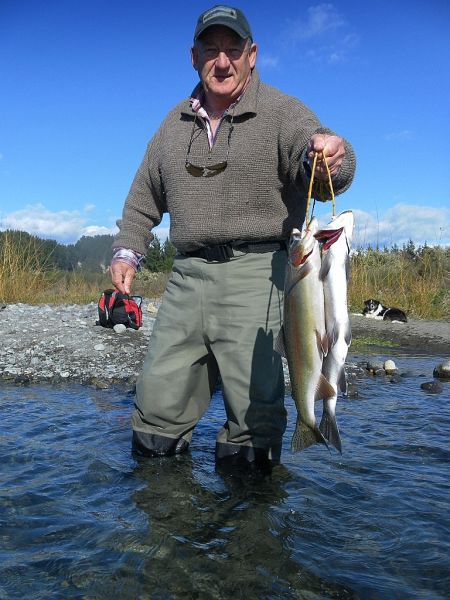 I bumped into Bob Bevece on the river who was doing ok swinging a wet-line. If your a skier whose stayed at Rocky Mountain Chalets in Ohakune you may recognise him. Ever since I bumped into Bob Bevece on the river who was doing ok swinging a wet-line. If your a skier whose stayed at Rocky Mountain Chalets in Ohakune you may recognise him. Ever since
I fished with Shamus a month or two ago I keep saying I must give the wet-line a go but I never get round to it...maybe...definitely this week. Angling pressure has been relatively light on parts of the Tongariro and there are some excellent fish being taken in amongst the recovering spawners. The forecast is for several days of rain or showers from late this weekend until next Wednesday. With the back country open many anglers will be looking forward to visiting their summer haunts. I don't like trying to second guess the fishing but with potentially fewer anglers around and the promise of rain it could be the best week so far...fingers crossed. 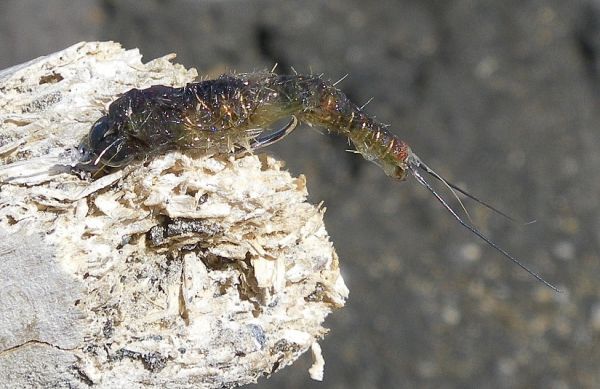
Tight Lines Guys
Mike |
|
|
| Back to Top |
|
|
|
|
|
|
|